New York State Police
The New York State Police (NYSP) is the official state police force of the U.S. state of New York and employs over 5,000 sworn state troopers. It is part of the New York State Executive Department, ref. Executive Law § 31. "There shall be in the executive department the following divisions: [...] The Division of State Police."
| New York State Police | |
|---|---|
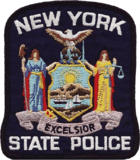 Patch | |
 Seal | |
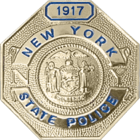 Shield | |
 Flag of the State of New York | |
| Common name | New York State Troopers |
| Abbreviation | NYSP |
| Motto | Excellence Through Knowledge |
| Agency overview | |
| Formed | April 11, 1917 |
| Employees | 5,711 (as of 2018)[1] |
| Annual budget | $926,123,000 (2018) |
| Jurisdictional structure | |
| Operations jurisdiction | New York, U.S. |
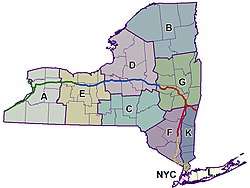 | |
| Troops of the New York State Police | |
| Size | 54,556 sq mi (141,300 km2) |
| Population | 19.4 million |
| Legal jurisdiction | New York, United States |
| Governing body | New York State Executive Department |
| General nature | |
| Headquarters | Building 22 W. Averell Harriman State Office Building Campus Albany, New York, United States |
| Troopers | 5,000[2] |
| Civilians | 711 (as of 2018) |
| Agency executive |
|
| Facilities | |
| Troops | 11 |
| Website | |
| Official Site | |

History

The State of New York did not establish a state police force until the early twentieth century. In part this reflected the pattern of settlement across a wide frontier. A number of proposals to create such a force during the early 1900s, but faced considerable opposition from trade union interests. They feared the police would be used against union organizing, as was happening in several other states.[3]
Following the 1913 murder of Sam Howell, a construction foreman in Westchester County, and failure of the local police to arrest suspects he had named before his death, the New York State Legislature passed a bill to establish a state police force. The New York State Police was officially established on April 11, 1917.
The division's first superintendent was George Fletcher Chandler, who was appointed by Governor Charles S. Whitman. Chandler is credited with much of the division's early organization and development. Chandler coined the term "New York State Troopers." He was an early advocate of officers carrying their weapons exposed on a belt, which was not common practice at the time.
On January 1, 1980, the Long Island State Parkway Police merged with the state police; this resulted in the official establishment of Troop L. In October 1997, the New York State Capital Police was consolidated and absorbed into the state police. As of late, there has been political debate concerning the New York State Park Police merging with the New York State Police.[4] On December 3, 2019, Governor Andrew Cuomo announced that the New York State Park Police will merge with the New York State Police. The merger is expected to take about six months.[5]
The New York State Police is also responsible for protecting the Governor of New York and the Lieutenant Governor of New York.
The New York State Police is one of only five state police agencies in the United States, that as of 2019, does not equip its state police vehicles with dashboard cameras. New York State Troopers have not been supplied with body cameras, either. Both tools have been significant in clearing police in wrongful use of force cases.[6]
Fallen officers
Since the establishment of the New York State Police, 137 officers have died while on duty.[7]
Superintendents
The New York State Police is headed by the Superintendent of the State Police, who is nominated by the Governor of New York and confirmed by the New York State Senate. The Superintendent of State Police commands more than 5,000 troopers, investigators and civilian support staff who help provide a full range of policing and public safety services to New Yorkers on behalf of the New York State Police.
List of superintendents:
- George Fletcher Chandler, May 1, 1917 – December 1, 1923
- John Adams Warner, December 1, 1923 – December 21, 1943
- John Aloysius Gaffney, December 22, 1943 – August 15, 1953
- Albin Severin Johnson, August 16, 1953 – January 24, 1955
- Francis Simpson McGarvey, January 24, 1955 – February 8, 1961
- Arthur Cornelius Jr., February 9, 1961 – August 4, 1967
- William Edward Kirwan Jr., August 5, 1967 – June 25, 1975
- William Gerard Connelie, July 2, 1975 – July 31, 1983
- Donald Osborn Chesworth Jr., August 1, 1983 – November 30, 1986
- Thomas A. Constantine, January 2, 1987 – March 21, 1994
- James W. McMahon, April 4, 1994 – August 20, 2003
- Wayne E. Bennett, September 16, 2003 – February 26, 2007
- Harry J. Corbitt, April 16, 2008 – March 3, 2010
- Joseph A. D'Amico, January 31, 2011 – June 9, 2016
- George P. Beach II, June 9, 2016 – January 16, 2019
- Keith M. Corlett, June 4, 2019 – present (Acting: January 16, 2019 – June 4, 2019)
Structure and organization
General
The New York State Police is headed by the Superintendent of the State Police, who is nominated by the Governor of New York and confirmed by the New York State Senate.
- Superintendent
- Field Command
- Uniform Force
- Field Troops
- Uniform Special Services
- Aviation Unit[8]
- Emergency Management Unit
- School and Community Outreach Unit
- Bomb Disposal Unit
- Canine Unit
- SCUBA Teams
- Special Operations Response Team (SORT)
Originally: Mobile Response Team (MRT) - Marine Unit
- Mountain Bicycle Patrol
- Snowmobile Unit
- All-Terrain Vehicle Patrol
- Highway Safety and Traffic Enforcement Services
- Bureau of Criminal Investigation (BCI)
- Gaming Detail
- Narcotics Enforcement Unit
- Computer Crime Unit
- Violent Felony Warrant Squad
- Community Narcotics Enforcement Teams / Gun Investigative Unit
- Forensic Investigation Support Services
- Campus Sexual Assault Victims Unit (CSAVU)
- Office of Counter Terrorism
- State Police Intelligence Center
- Border Intelligence Unit
- CALEA Intercept Unit
- Criminal Gun Clearinghouse
- Criminal Intelligence Unit
- Counter Terrorism Center
- Electronic Surveillance Unit
- Financial Crimes Unit
- Gang Intelligence Unit
- Narcotics Intelligence Unit
- Source Development Unit
- Special Investigation Unit
- Uniform Force
- Division Headquarters
- Administration
- Technology and Planning
- Employee Relations
- Human Resources
- Professional Standards Bureau
Originally: Internal Affairs Bureau
- Field Command
Since February 1994, the agency has accepted DNA evidence for forensic investigation and analysis. The New York State Police Forensic Investigation Center (FIC) opened in November 1996. The Crime Laboratory performs DNA analysis for state investigations and for local law enforcement. It includes a new DNA Data Bank Section that compiles DNA records from violent felons sentenced to prison in New York State. These records can be searched and compared by computer to other evidence collected in unsolved crimes.[9]
Troops
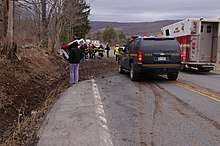
The NYSP divides New York state geographically into eleven "Troops," each comprising a specific geographic area, usually several counties. Each is supervised by a "Troop Commander" usually of the rank of Major.[10] NYSP Troops cover the following counties and regions as listed:
Each Troop encompasses 2–4 "Zones" which are referred to simply by a Zone number. There are up to several "sub-stations" located within each zone.
Uniforms and ranks
Trooper uniforms are made of grey wool, with the exception of the Gore-Tex jacket. Prior to 1958, uniforms (shirts, jackets and britches) were woven of equal parts white fiber and black fiber to symbolize the impartiality of justice. The NYSP is one of only five state police forces who do not wear a badge on their uniform shirts.[12] Like a U.S. flag, trooper uniforms are burned when no longer serviceable. The black stripe down the leg of the trouser represents remembrance of fallen comrades. The purple color of the tie and hat band represents an elite unit. Troopers wear a tan felt Stetson hat with a leather security strap and purple band around it.[13]
- Rank insignia
| Title | Insignia |
|---|---|
| Superintendent | |
| First Deputy Superintendent | |
| Deputy Superintendent/Colonel | |
| Assistant Deputy Superintendent/Lieutenant Colonel | |
| Staff Inspector | |
| Major | |
| Captain | |
| Lieutenant | |
| Technical Lieutenant | |
| Chief Technical Sergeant |  |
| Staff Sergeant |  |
| First Sergeant |  |
| Senior Investigator (plainclothes) | No insignia |
| Zone Sergeant |  |
| Sergeant Station Commander |  |
| Technical Sergeant |  |
| Sergeant |  |
| Investigator (plainclothes) | No insignia |
| Trooper | No insignia |
Chevrons are black on a gray background and are worn on the upper sleeves of both the shirt and the jacket. Rank insignia for Technical Lieutenant through Superintendent are worn on the collars of the shirt and the shoulder loops of the Gore-Tex jacket.
Communication officer for the state police (911 operators State police)
Communication specialists are often the life line for citizens throughout the state who are in need of immediate emergency assistance. These specialized individuals take citizen complaints, dispatch troopers to calls for service and emergencies, and answer cellular 911 calls. These employees also provide medical information to citizens over the telephone, ranging from instructions on delivering a baby to performing CPR on an unresponsive person.[14]
Car numbers
A patrol car number will contain the Troop and Zone or group prefix: for example, car 1A30 would be a patrol car in Zone 1 of Troop A. Prefix numbers 1 through 4 are used for geographic patrol zones, while 5 is used by BCI Investigators, 6 by Portables, 7 by other local agencies dispatched by NYSP, 8 by special state units (e.g. State Park Police), and 9 by dispatchers. Cars not carrying prefixes, for instance K55, are Troop Headquarters cars. The New York State Police also use a standard number-blocking system to identify the type of unit carrying a particular number:
Administrative
- L1 - Major
- L2 - Captain (executive officer)
- L5 - Bureau of Criminal Investigation Captain
- L10-L49 - Troop Administration - Marked cars
- L50-L69 - Troop Administration - Unmarked cars
- L70-L89 - Miscellaneous Administration
- L90-L99 - Troop Communications
- L101-L109 - Traffic Incident Management Team
Uniformed Troopers
- 1L1 - Captain (Zone Commander)
- 1L2 - Lieutenant
- 1L10-1L49 - Marked Cars
- 1L50-1L79 - Unmarked Cars
- 1L80-1L89 - Miscellaneous Units
Bureau of Criminal Investigation (BCI)
- L5 - BCI Captain
- 5L1 - BCI Lieutenant
- 5L15-5L24 - BCI Senior Investigators
- 5L25-5L199 - BCI Investigators
Portables
- 6L1-6L99 - Administrative Portables
- 6L100-6L499 - Trooper Portables
- 6L500-6L599 - BCI Portables
Special Units
- Henry (H) - State Police Headquarters Division
- Nora (N) - State Environmental Conservation P.D.
- Robert (R) - State Police Academy Units
- Sam (S) - State Police Special Investigations Units
Training
Recruits must complete a 26-week training academy prior to being appointed as a state trooper. The residential school is located at the New York State Police Academy in the capital, Albany, New York. Recruits must then complete 10 weeks post academy field training with a trained field training officer (FTO) holding the rank of trooper prior to permanent troop assignment.
Equipment
As of January 2018, New York State Troopers are issued the Glock 21 Gen 4 (.45 ACP) as their service pistol. New York State Troopers previously used the Glock 37 (.45 GAP) from 2007 to 2018. The New York State Police used the Glock 17 (9mm) from 1990 to 2007, the Glock 17 replaced the Smith & Wesson Model 686 (NYSP issued the Model 681).[15] The Glock 37 was adopted after the shooting death of Trooper Andrew Sperr in Chemung County on March 1, 2006, which led to the call for a heavier round with more stopping power. But this has cost a loss in magazine capacity from 17 to 10 bullets. The Glock 37 was chosen because it retains the .45 caliber ballistics but in the trimmer Glock 17 frame more suitable for a range of hand size. In addition, New York State Troopers are also armed with Remington 870 patrol shotguns and Rock River Arms AR-15 "LAR-15 Tactical Entry Model" semi-automatic patrol rifles.
Effective Spring 2011, New York State Troopers were trained and issued tasers for patrol purposes. The tasers were donated by the NYS Trooper Foundation to give Troopers, who almost always patrol alone, an alternative to deadly force to subdue combatants.
The State Police's vehicle fleet is primarily made up of Ford Explorer and Dodge Charger vehicles. These are slowly replacing the Crown Victorias that the State Police previously used as its primary patrol car. The fleet also uses for routine patrol Chevrolet Caprice, Ford Expeditions, and Chevrolet Tahoes. All marked cars are painted dark blue with yellow reflective decals.
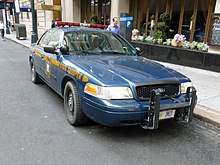
Vehicles in the Concealed Identity Traffic Enforcement program (CITE) are unmarked. This program uses Ford Explorer and Chevrolet Tahoe vehicles.
Aviation
The New York State Police has three Bell 407 single engine utility helicopters, six Bell 430 twin engine helicopters, three Bell UH-1 “HUEY 2” Single engine utility helicopters and one UH-1H “HUEY 1” Single engine utility helicopter. Their other aircraft are two Cessna 206 Stationair Single engine airplanes, one Cessna 172 Single engine airplane, one Partenavia 68 Twin engine observation airplane, one Sikorsky 76 (used for transporting the governor), and two Beech King Air twin engine turboprop airplanes. All of these aircraft operate under the call sign “GreyRider”.[16]
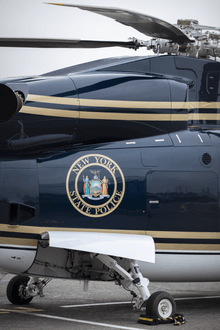
See also
- New York State Police Troop C scandal
- List of law enforcement agencies in New York
- New York State University Police
- State Police (United States)
- Highway Patrol
Notes
- NYSP Troop T was responsible for protecting Interstate 84 from 1991 to 2010 because the New York State Thruway Authority (NYSTA) maintained Interstate 84. However, due to the transfer of maintenance from NYSTA back to the NYSDOT in October 2010, NYSP Troop T no longer patrols Interstate 84 as patrolling duties were reassigned to Troop F and Troop K.
References
- "NYS DOB: FY 2018 Executive Budget | Agency Appropriations | State Police, Division of". www.budget.ny.gov. Retrieved 2018-06-10.
- http://www.wktv.com/content/news/208-troopers-graduate-from-NY-State-Police-Academy-472146343.html
- Van de Water, Frederic Franklyn (1922). Grey Riders: The Story of the New York State Troopers. Putnam's Sons.
- "Officials: NY considers merge of State, park police". Newsday.
- Slattery, Denis. "Gov. Cuomo says New York State Police will absorb State Park Police Officers in union-backed move". nydailynews.com.
- Associated Press (23 July 2019). "N.Y. State Police lag behind agencies nationwide". Sentinel and Enterprise. Retrieved 19 September 2019.
- The Officer Down Memorial Page
- Aviation Unit
- , Troopers, NY
- NYSP site http://www.troopers.ny.gov/Contact_Us/Troop_Information/
- Rife, Judy (October 11, 2010). "DOT takes over maintenance on I-84". Times Herald-Record. Middletown, NY. Retrieved October 13, 2010.
- Kidd, R. Spencer (2012). Uniforms of the U.S. State Police & Highway Patrols. lulu.com. p. 11. ISBN 978-1-4717-7729-5. OCLC 929822564.
- NYSP Uniform
- New York State Police to Purchase New Glock Pistol
- "Current Equipment". New York State Police. Retrieved 15 February 2019.
External links
- New York State Police website
- New York State Police in the New York Codes, Rules and Regulations
- NYSP Recruitment Center website
- Union representing Troopers and Supervisors
- Union representing Investigators
- "New York State Police collected news and commentary". The New York Times.
| Wikimedia Commons has media related to |